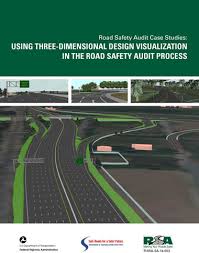Road Safety Audit: Enhancing Safety on our Roads
With the increasing number of vehicles on the roads and the ever-growing challenges of urbanization, ensuring road safety has become a critical concern for authorities worldwide. One effective tool that plays a significant role in enhancing road safety is the Road Safety Audit.
A Road Safety Audit is a formal examination of an existing or planned road or traffic project by an independent team of experts. The primary objective of this audit is to identify potential safety issues and recommend measures to eliminate or mitigate them. The audit process involves assessing various elements such as road design, traffic flow, signage, visibility, and overall infrastructure to ensure that they meet safety standards and guidelines.
One of the key benefits of conducting a Road Safety Audit is the proactive identification of potential hazards before they lead to accidents. By evaluating different aspects of road design and traffic management, auditors can pinpoint areas that pose risks to road users and propose solutions to address these issues effectively.
Furthermore, Road Safety Audits help in improving the overall quality of road infrastructure by incorporating safety considerations from the early stages of planning and design. This proactive approach not only enhances safety but also leads to cost savings in the long run by reducing the likelihood of accidents and their associated expenses.
It is essential for authorities, planners, and engineers involved in road construction and maintenance to prioritize Road Safety Audits as part of their project development process. By integrating safety audits into every stage of road development – from planning and design to construction and operation – we can create roads that are safer for all users.
In conclusion, Road Safety Audits play a crucial role in identifying potential hazards on our roads and implementing measures to enhance safety for motorists, pedestrians, and cyclists alike. By making road safety a top priority through regular audits and improvements, we can work towards creating a safer environment for everyone who uses our roads.
Key Benefits of Conducting Road Safety Audits for Enhanced Infrastructure and Public Safety
- Proactive identification of potential hazards before accidents occur.
- Enhancement of road infrastructure quality by incorporating safety considerations early on.
- Cost savings in the long run by reducing accident-related expenses.
- Improved safety for motorists, pedestrians, and cyclists.
- Integration of safety audits at every stage of road development process.
- Creation of a safer environment for all road users.
Challenges and Drawbacks of Road Safety Audits: Key Considerations
- Costly to conduct, especially for large-scale road projects
- Time-consuming process that may delay project timelines
- Requires specialized expertise and training for auditors
- Potential resistance from stakeholders to implement audit recommendations
- Limited effectiveness if audit recommendations are not implemented properly
- May lead to conflicts between safety improvements and other project objectives
- Challenges in assessing subjective factors like driver behavior and perception
Proactive identification of potential hazards before accidents occur.
One of the key advantages of Road Safety Audits is the proactive identification of potential hazards before accidents occur. By conducting thorough assessments of road design, traffic flow, signage, and other infrastructure elements, auditors can pinpoint areas that pose risks to road users. This early detection allows for timely implementation of corrective measures to eliminate or mitigate these hazards, ultimately preventing accidents and ensuring the safety of all individuals using the roads.
Enhancement of road infrastructure quality by incorporating safety considerations early on.
The proactive approach of incorporating safety considerations early on in road infrastructure projects through Road Safety Audits leads to the enhancement of overall road infrastructure quality. By identifying potential safety hazards at the planning and design stages, road safety audits enable engineers and planners to implement necessary measures to address these issues effectively. This not only ensures that roads are built to meet safety standards but also helps in reducing the risk of accidents and improving the longevity of the infrastructure, ultimately creating safer and more reliable roads for all users.
Cost savings in the long run by reducing accident-related expenses.
By conducting Road Safety Audits and addressing potential hazards proactively, significant cost savings can be achieved in the long run by reducing accident-related expenses. By identifying and mitigating safety risks early on, road authorities can prevent accidents from occurring, thereby avoiding the costs associated with emergency response, medical treatment, vehicle repairs, legal proceedings, and other accident-related expenses. Investing in road safety through audits not only saves lives but also leads to financial savings by creating safer road infrastructure that minimizes the likelihood of accidents and their costly repercussions.
Improved safety for motorists, pedestrians, and cyclists.
Road Safety Audits offer a significant pro in the form of improved safety for motorists, pedestrians, and cyclists. By conducting thorough audits of road infrastructure and traffic management systems, potential hazards can be identified and addressed proactively. This leads to the implementation of safety measures that benefit all road users, reducing the risk of accidents and ensuring a safer environment for everyone on the road. Prioritizing Road Safety Audits ultimately contributes to creating a more secure and inclusive transportation network that caters to the needs of motorists, pedestrians, and cyclists alike.
Integration of safety audits at every stage of road development process.
The integration of safety audits at every stage of the road development process is a proactive approach that helps in identifying and addressing potential safety hazards early on. By incorporating safety considerations from the initial planning and design phases through to construction and operation, road safety audits ensure that safety remains a top priority throughout the entire lifecycle of a road project. This systematic approach not only helps in preventing accidents but also leads to the creation of safer road infrastructure that benefits all road users in the long term.
Creation of a safer environment for all road users.
The Road Safety Audit process significantly contributes to the creation of a safer environment for all road users. By systematically identifying and addressing potential hazards on roads, such as unsafe intersections, inadequate signage, or poor visibility areas, the audit helps enhance overall road safety. This proactive approach not only reduces the risk of accidents but also promotes a culture of safety among motorists, pedestrians, cyclists, and other road users. Ultimately, the implementation of recommendations from Road Safety Audits leads to improved infrastructure and better-designed roads that prioritize the well-being and safety of everyone on the road.
Costly to conduct, especially for large-scale road projects
One significant drawback of Road Safety Audits is the high cost associated with conducting them, particularly for large-scale road projects. The expenses involved in assembling a team of independent experts, conducting on-site evaluations, analyzing data, and implementing recommended safety measures can place a considerable financial burden on project budgets. This cost factor may deter some authorities or organizations from prioritizing Road Safety Audits, especially when faced with limited resources and competing demands for funding in infrastructure development projects.
Time-consuming process that may delay project timelines
One significant drawback of Road Safety Audits is that they can be a time-consuming process that may potentially delay project timelines. Conducting a thorough audit requires detailed inspections, data collection, analysis, and the formulation of recommendations, all of which can take a considerable amount of time. As a result, project schedules may be extended, leading to delays in the completion of road construction or improvement projects. This delay can be frustrating for stakeholders and may impact the overall efficiency of the project delivery process.
Requires specialized expertise and training for auditors
One significant drawback of Road Safety Audits is that they require specialized expertise and training for auditors. Conducting a thorough audit involves assessing various technical aspects of road design, traffic flow, signage, and infrastructure, which demands a high level of knowledge and experience in the field of road safety engineering. Finding auditors with the necessary qualifications and expertise can be challenging, leading to potential delays in conducting audits or compromising the quality of the audit findings. Moreover, the cost associated with training auditors and maintaining their proficiency adds an additional burden to the overall implementation of Road Safety Audits.
Potential resistance from stakeholders to implement audit recommendations
One significant con of Road Safety Audits is the potential resistance from stakeholders to implement audit recommendations. Despite the valuable insights and suggestions provided by the audit team, stakeholders such as road authorities, developers, and policymakers may encounter challenges in accepting and executing the proposed safety measures. This resistance could stem from various factors, including budget constraints, conflicting priorities, lack of awareness about the importance of road safety, or reluctance to make changes to existing infrastructure. Overcoming this resistance requires effective communication, collaboration, and a shared commitment to prioritize road safety for the benefit of all road users.
Limited effectiveness if audit recommendations are not implemented properly
A significant drawback of Road Safety Audits is their limited effectiveness if the recommendations provided are not implemented properly. Despite identifying potential safety issues and proposing solutions, the impact of these audits relies heavily on the willingness and capacity of authorities to act upon the recommendations. If the suggested safety measures are not executed or are only partially implemented, the intended benefits of the audit may not be fully realized, leaving road users vulnerable to preventable accidents and hazards. Therefore, ensuring that audit recommendations are diligently followed through and integrated into road infrastructure projects is essential to maximize the effectiveness of Road Safety Audits in improving overall road safety.
May lead to conflicts between safety improvements and other project objectives
Road Safety Audits, while crucial for identifying and addressing potential hazards on roads, may sometimes lead to conflicts between safety improvements and other project objectives. In some cases, prioritizing safety measures recommended in the audit may clash with other project goals such as cost-effectiveness, timeline adherence, or environmental considerations. Balancing the need for enhanced safety with these competing objectives can pose challenges for project stakeholders, requiring careful evaluation and decision-making to ensure a harmonious integration of safety improvements without compromising overall project success.
Challenges in assessing subjective factors like driver behavior and perception
Assessing subjective factors such as driver behavior and perception poses a significant challenge in road safety audits. Unlike objective elements like road design and signage, which can be measured and evaluated more easily, understanding and quantifying the human factor is complex. Driver behavior can vary greatly based on individual characteristics, experience, mindset, and external factors like weather conditions or distractions. Perception of risks and response times are subjective aspects that are influenced by numerous variables, making it challenging to standardize assessments in road safety audits. Addressing these subjective factors requires a nuanced approach that considers human psychology and behavior to effectively improve overall road safety measures.




